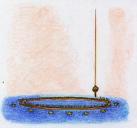
Click for a video of the pendulum


While our clocks are set by an average 24 hour day for the passage of the Sun from noon to noon, the Earth rotates on its axis in 23 hours 56 minutes and 4.1 seconds with respect to the rest of the universe. From our perspective here on Earth, it appears that the entire universe circles us in this time. It is possible to do some rather simple experiments that demonstrate that it is really the rotation of the Earth that makes this daily motion occur.
In 1851 Leon Foucault (1819-1868) was made famous when he devised an experiment with a pendulum that demonstrated the rotation of the Earth. Joseph Ashbrook's book, The Astronomical Scrapbook, (Cambridge University Press, 1984) has a short chapter on Foucault's contributions to astronomy. Inside the dome of the Pantheon of Paris he suspended an iron ball about 1 foot in diameter from a wire more than 200 feet long. The ball could easily swing back and forth more than 12 feet. Just under it he built a circular ring on which he placed a ridge of sand. A pin attached to the ball would scrape sand away each time the ball passed by. The ball was drawn to the side and held in place by a cord until it was absolutely still. The cord was burned to start the pendulum swinging in a perfect plane. Swing after swing the plane of the pendulum turned slowly because the floor of the Pantheon was moving under the pendulum.
We know this device today as the Foucault pendulum. Almost every major science museum has one on display. We have ours here at the University of Louisville too, in the dome of Grawemeyer Hall, the administration building.
Click here for more a detailed pdf document (5MB) about the University of Louisville's Foucault pendulum along with technical notes and the original working drawings.
